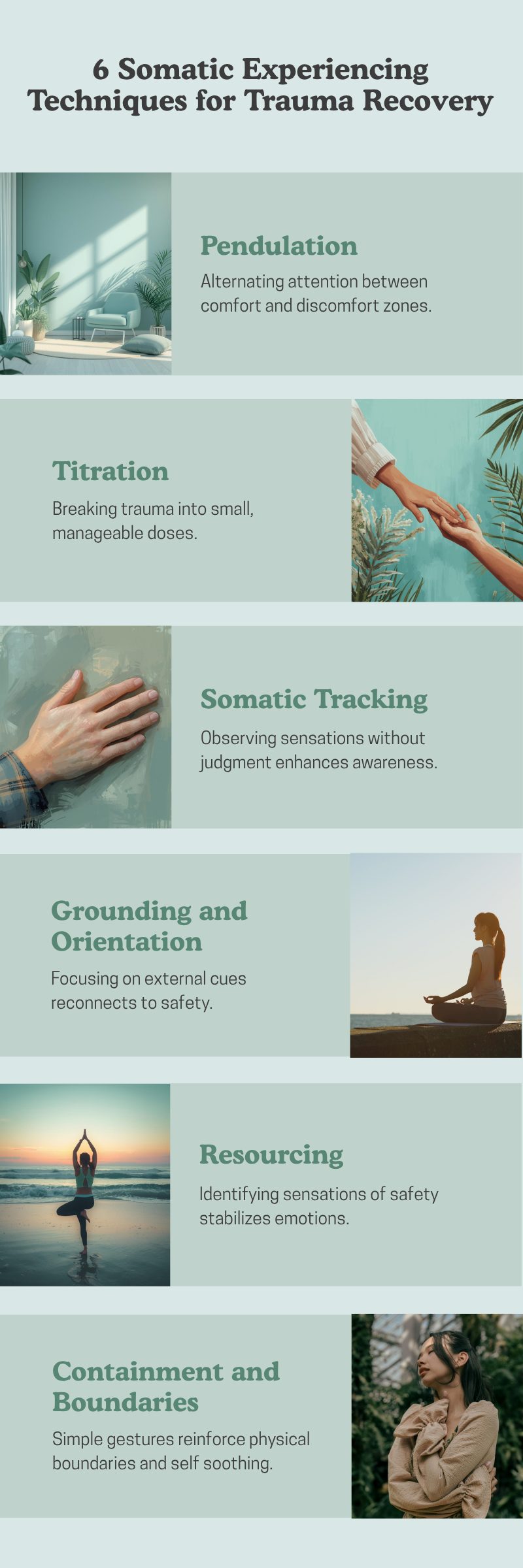Blog > Treatment Strategies > Somatic Experiencing Techniques & Exercises to Heal Trauma in the Body
Somatic Experiencing Therapy: Techniques and Exercises for Healing Trauma in the Body
Somatic experiencing therapy helps clients reconnect with their bodies to release the effects of stored trauma and restore nervous system balance. Through gentle awareness, movement, and grounding techniques, this body-based approach supports healing from the inside out. In this guide, we’ll explore core somatic experiencing techniques, practical somatic experiencing exercises, and other somatic therapy techniques that promote embodied recovery.

Last Updated: October 10, 2025


What You'll Learn
-
The key principles behind somatic experiencing therapy and how it supports trauma recovery
-
Step-by-step examples of somatic experiencing techniques and exercises you can use in sessions
-
An overview of different types of somatic therapy and how they compare to somatic experiencing
-
How healing trauma in the body restores regulation, safety, and resilience
-
Tips for integrating somatic interventions into trauma-informed practice
Contents
- What is Somatic Experiencing Therapy
- The Role of Body Awareness in Trauma Recovery
- Who Can Benefit From Somatic Experiencing Therapy?
- Common Somatic Experiencing Techniques and Exercises
- Types of Somatic Therapy
- Comparison of Somatic Therapy Modalities
- Healing Trauma in the Body
- Integrating Somatic Therapy Techniques in Clinical Practice
- Measuring Progress and Supporting Safety
- FAQ: Somatic Experiencing and Body-Based Trauma Healing
Somatic experiencing (SE) is a body-centered, trauma-informed therapy designed to help individuals heal trauma in the body by restoring nervous system balance. Developed by Peter Levine, Ph.D., this approach recognizes that trauma isn’t only stored in the mind — it lives in the body, influencing physical sensations, posture, and emotional regulation.
In this guide, we’ll explore somatic experiencing techniques, somatic experiencing exercises, and other somatic therapy techniques that promote embodied healing. You’ll also discover the different types of somatic therapy used in trauma recovery and how clinicians can integrate them safely into practice.
What Is Somatic Experiencing Therapy?
While somatics has been around since the 19th century, Peter Levine, Ph.D., introduced the concept of somatic experiencing after spending years studying trauma responses in wild animals. According to the website for Levine's nonprofit, Somatic Experiencing International (SEI), SE is the result of extensive multidisciplinary study and research on the following:
- Stress physiology
- Psychology
- Ethology
- Biology
- Neuroscience
- Indigenous healing practices
- Medical biophysics
Somatic experiencing is based on the idea that trauma becomes “trapped” when the body’s natural stress response is interrupted. Through guided awareness of bodily sensations, clients learn to complete these responses and reestablish a sense of safety and regulation.
A trained therapist typically facilitates somatic experiencing. Each session focuses on managing the physiological and nervous system dysregulation that accompanies trauma. The therapist uses different techniques to help clients notice sensations, impulses, and emotions in small, manageable increments — a process known as titration. By pacing the work carefully, SE enables clients to release tension and restore self-regulation of their bodily responses — and ultimately heal from their past.
Somatic Experiencing vs. Other Trauma Therapies
While many trauma therapies aim to help clients process distressing experiences, each approaches healing in a different way. The comparison below highlights how somatic experiencing stands apart by emphasizing body awareness and nervous system regulation.
- Cognitive processing therapy (CPT): A cognitive behavior therapy focused on identifying and challenging distorted beliefs around a traumatic experience. Unlike SE, CPT concerns itself with mental and emotional processes rather than the body.
- Prolonged exposure therapy (PE): This treatment involves gradual exposure to triggering memories or situations. It highlights the role of avoidance in prolonging the healing process, but it does not emphasize physiological regulation like SE therapy.
- Eye movement desensitization and reprocessing (EMDR): EMDR incorporates repetitive back-and-forth eye movements to promote the processing of traumatic memories. While this style of therapy does not focus primarily on body awareness, it does involve eye movements and physical stimulation similar to SE.
The Role of Body Awareness in Trauma Recovery
Traumatic life events can sometimes cause an individual to disconnect from their body as a means of coping with an overwhelming or terrible experience.
Body awareness plays a critical role in the recovery process as it helps the individual foster an intentional connection between the mind and body. By focusing on physical sensations and emotions in tandem, those receiving therapy can learn how their unique body responds to triggers and stress. This awareness is key to finding effective coping mechanisms.
Somatic trauma therapy aids emotional regulation by doing the following:
- Promoting body awareness
- Calming the nervous system
- Building resilience to triggers
- Completing unresolved trauma responses
- Finding body-based coping strategies
- Fostering the mind-body connection
Who Can Benefit From Somatic Experiencing Therapy
SE is particularly effective for treating individuals with post-traumatic stress disorder (PTSD). The symptoms of PTSD can be mild or severe, depending on the person and their unique situation. The characteristic symptoms of this disorder include:
- Intrusive thoughts.
- Avoidance of trauma-related stimuli.
- Persistent physiological hyperarousal.
Different SE strategies can help people with PTSD alleviate dysregulation and enhance feelings of stability.
Somatic experiencing can also be an advantageous option for individuals who are overwhelmed with stress. Whether they are dealing with anxiety, panic attacks or insomnia, SE can help patients overcome these symptoms and find peace.
Those with dissociative disorders or tendencies can also benefit from SE therapy. It can help restore a sense of safety, empowerment of self and unity between one's mind and body.
Free Download: Somatic Exercises Worksheets for Trauma Recovery
Help your clients reconnect with their bodies and regulate the nervous system through gentle, guided somatic awareness practices.
Each page offers a practical, body-based activity to help clients build safety, presence, and self-compassion.
These trauma-informed worksheets are ideal for use in individual therapy, group sessions, or as between-session resources to promote embodied healing.
Common Somatic Experiencing Techniques and Exercises
Somatic experiencing practitioners use gentle interventions to help clients access and release stored tension. Below are key somatic experiencing exercises and techniques often used in therapy.
- Pendulation: Pendulation is a popular technique for somatic experiencing therapy that involves alternating attention between areas of comfort and discomfort to help the nervous system expand its capacity for sensation without overwhelm. By practicing tolerance, the client can become more resilient when facing adverse stimuli and stressors. Switching back and forth between these states allows for calmer bodily responses and a greater sense of emotional stability.
- Titration: This technique involves the gradual exploration of traumatic experiences. An SE therapist guides the client through traumatic material in tiny, tolerable doses to prevent retraumatization and promote gradual regulation. Titration allows individuals to process and work through their physical and emotional feelings at a pace that feels safe and not overwhelming.
- Somatic Tracking: Another useful SE therapy technique is somatic tracking, where a therapist works to ease physical pain stored in the body from trauma. The point is for the client to recognize the pain without emotional reactivity to mindfully examine the discomfort and release it. Clients observe internal sensations — heat, tension, tingling — without judgment, building interoceptive awareness.
- Grounding and Orientation: SE therapy patients can benefit from learning how to orient to the present moment and create a sense of groundedness within the body. This can be a form of meditation to soothe the mind and body by bringing awareness away from traumatic or overwhelming memories. By focusing on external cues (the room, sounds, or breath), clients reconnect to the present moment and sense of safety.
- Resourcing: Resourcing is a foundational somatic experiencing technique that helps clients identify and strengthen sensations of safety and stability within the body. A “resource” can be anything that evokes comfort or grounding — such as a supportive memory, a loved one, a calming sound, or a physical anchor like feeling the feet on the floor. During resourcing, clients are guided to notice where in the body they feel relaxed or strong and to stay with that sensation. Over time, this practice expands the nervous system’s ability to regulate stress and provides a steady base from which deeper trauma work can safely unfold.
- Containment and Boundaries: Containment and boundary techniques are used in somatic experiencing therapy to help clients establish a sense of safety and control during trauma processing. These exercises often involve gentle physical gestures — such as placing a hand over the heart, wrapping the arms around the torso, or visualizing a protective boundary around the body — to reinforce personal space and internal stability. By consciously defining where the self begins and ends, clients can better manage overwhelming sensations and emotions. This somatic therapy practice supports emotional regulation and fosters a felt sense of agency and protection within the therapeutic process.

These somatic therapy techniques can be practiced in or between sessions as part of a structured trauma-healing plan.
Types of Somatic Therapy
While Somatic Experiencing (SE) is one of the most well-known body-based trauma treatments, clinicians have access to a range of complementary somatic therapy modalities that integrate movement, mindfulness, and body awareness into psychotherapy. Understanding these approaches can help clinicians tailor interventions to each client’s needs and training scope.
Sensorimotor Psychotherapy (SP)
Created by Pat Ogden, SP combines cognitive and emotional processing with somatic awareness. It explores how trauma is held in movement patterns, gestures, and postural habits. Clinicians use mindfulness of bodily experience to help clients recognize automatic responses, integrate dissociated states, and develop new patterns of physical and emotional regulation. This model is particularly effective for complex trauma and attachment disruptions.
Hakomi Method
Developed by Ron Kurtz, Hakomi integrates mindfulness and body awareness to uncover unconscious core beliefs that shape behavior. Clients learn to observe present-moment experience — sensations, thoughts, and impulses — with curiosity rather than judgment. The therapist acts as a compassionate guide, helping clients bring implicit material into consciousness and transform long-held patterns through mindful experiments. Hakomi aligns well with humanistic and transpersonal orientations.
Trauma Release Exercises (TRE)
Founded by David Berceli, TRE uses a series of simple physical movements designed to elicit the body’s natural tremor response, releasing deep muscular tension and neurophysiological stress. Clinicians can incorporate TRE as a complementary practice for clients who need nonverbal outlets for chronic hyperarousal or muscular bracing. Proper instruction and safety screening are essential, especially for clients with complex trauma or dissociative tendencies.
Bioenergetic Analysis
Originating from the work of Alexander Lowen and Wilhelm Reich, this approach links emotional health with bodily expression. It focuses on releasing chronic muscular contractions, “body armor,” that develop as defenses against emotional pain. Therapists guide clients through breathing, grounding, and expressive movement exercises that restore vitality, assertiveness, and embodied presence. Bioenergetic techniques require specialized training and close attention to somatic boundaries.
Somatic Movement Practices (Feldenkrais, Alexander Technique, Rolfing)
These modalities use mindful movement and postural alignment to retrain the nervous system’s coordination patterns. While often taught outside traditional psychotherapy, they can complement clinical work by increasing interoceptive awareness and reducing physical tension that perpetuates trauma symptoms. Many clinicians collaborate with movement specialists to support holistic regulation and integration.
Comparison of Somatic Therapy Modalities
| Modality | Founder / Key Developer | Core Methods | Best Suited For | Training Focus for Clinicians |
|---|---|---|---|---|
| Somatic Experiencing (SE) | Peter Levine, Ph.D. | Pendulation, titration, and somatic tracking to complete interrupted fight–flight–freeze responses and restore nervous system regulation. | PTSD, shock trauma, chronic stress, and clients who dissociate from bodily sensations. | Requires SE Professional Training (3-year certification); emphasizes pacing, nervous system education, and trauma discharge. |
| Sensorimotor Psychotherapy (SP) | Pat Ogden, Ph.D. | Mindful tracking of posture, gesture, and movement patterns; integration of cognitive, emotional, and somatic processing. | Complex trauma, attachment wounds, and dissociation linked to body memory. | Modular training in trauma and developmental repair; integrates attachment theory and mindfulness. |
| Hakomi Method | Ron Kurtz | Mindfulness-based awareness of body sensations to uncover implicit beliefs and transform emotional patterns through gentle experiments. | Clients seeking insight-oriented, mindfulness-driven body psychotherapy. | Hakomi Professional Training focuses on presence, mindfulness, and experiential process facilitation. |
| Trauma Release Exercises (TRE) | David Berceli, Ph.D. | Series of physical movements to induce neurogenic tremors and release stored muscular tension. | Clients with chronic stress, muscular bracing, or limited verbal processing capacity. | Practitioner training emphasizes safety, screening for trauma complexity, and self-regulation skills. |
| Bioenergetic Analysis | Alexander Lowen, M.D. (based on Wilhelm Reich) | Combines bodywork, breath, and expressive movement to release emotional suppression and restore vitality. | Clients with somatic defenses, chronic tension, or inhibited emotional expression. | Certification through the International Institute for Bioenergetic Analysis; includes supervision and experiential work. |
| Somatic Movement Practices | Various (Feldenkrais, Alexander Technique, Rolfing) | Mindful movement, postural alignment, and sensory re-education to improve coordination and body awareness. | Clients with chronic pain, posture issues, or limited body awareness who benefit from nonverbal regulation strategies. | Most require certification in specific modalities; can be integrated adjunctively into trauma-informed psychotherapy. |

Clinical Insight
Each somatic therapy model approaches trauma recovery through the body, yet they differ in theoretical focus and depth of psychotherapeutic processing. Clinicians integrating these techniques should seek appropriate training and supervision to ensure safety, scope of practice, and ethical implementation.
Healing Trauma in the Body
Trauma activates the body’s fight-flight-freeze system. When this activation is incomplete, energy becomes “stuck,” leading to chronic anxiety, pain, or dissociation. Healing trauma in the body means restoring the natural rhythm between activation and rest.
Through somatic experiencing techniques, clients gradually reconnect with bodily sensations, allowing previously frozen responses to complete. Over time, this process enhances emotional regulation, bodily awareness, and resilience.
Clinically, this aligns with polyvagal theory, which emphasizes the role of the vagus nerve in safety and connection. Somatic therapy helps clients return to a regulated state where healing can occur.
Integrating Somatic Therapy Techniques in Clinical Practice
Clinicians can introduce somatic experiencing exercises with gentle pacing and clear consent. Begin with grounding or resourcing activities before exploring deeper sensations. Encourage clients to notice bodily shifts, temperature changes, or impulses without forcing interpretation.
For self-practice, invite clients to take “somatic pauses” during the day — brief check-ins with posture, breathing, or tension levels — to promote regulation between sessions.
Integrating SE therapy techniques into your practice can be highly advantageous, especially for working with clients suffering from the weight and impact of their traumatic experiences.
By developing trauma-informed care approaches at your practice, you can help those struggling to cope after a traumatic event by offering a safe environment to carefully work through triggers and develop a deeper understanding of trauma and its impacts.

Tip
Always ensure a strong therapeutic alliance and avoid pushing clients beyond their window of tolerance.
Measuring Progress and Supporting Safety
Evaluating progress in somatic experiencing therapy requires attention to both physiological and psychological indicators of change. Because trauma is stored in the body as well as the mind, healing is often reflected in subtle shifts in regulation, posture, and sensation before major cognitive or emotional breakthroughs occur.
Signs of progress may include:
-
Improved nervous system regulation, such as steadier breathing, reduced hyperarousal, or fewer episodes of shutdown or dissociation.
-
Reduction in somatic and trauma-related symptoms, including decreased muscle tension, fewer stress-related physical complaints, improved sleep, and diminished startle or anxiety responses.
-
Increased interoceptive awareness — the client’s ability to notice and tolerate bodily sensations without fear or avoidance.
-
Enhanced emotional regulation and a greater sense of presence, safety, and agency during and between sessions.
-
More adaptive behavioral responses to stressors, such as reaching out for support rather than withdrawing or dissociating.
Because somatic work can activate deeply held material, safety and pacing remain paramount. If clients experience flooding, dissociation, or physiological overwhelm, sessions should return to grounding and resourcing before reengaging traumatic material.
Clinicians can document these changes by noting shifts in both observable behaviors and subjective reports of bodily experience. Over time, progress in somatic experiencing therapy often appears as an increased capacity for connection, flexibility, and self-regulation — clear markers of healing trauma in the body.
Documenting Somatic Experiencing Therapy with ICANotes
Accurate documentation is essential when providing body-based trauma therapy. ICANotes, a behavioral health EHR built specifically for mental health clinicians, simplifies the process of charting somatic experiencing sessions while maintaining compliance and clarity. In ICANotes, you can easily record nervous system regulation, safety interventions, and client progress using trauma-informed prompts and structured note templates.
Use ICANotes to:
-
Track physiological and emotional change — document observations such as relaxed posture, steadier breathing, or improved affect regulation.
-
Capture session focus — note specific interventions like grounding, pendulation, or resourcing using built-in drop-down menu options or custom text fields.
-
Document safety measures — record grounding strategies used when clients experience activation, including how they responded to regulation prompts.
-
Link progress to treatment goals — tie observed improvements in somatic and trauma symptoms to measurable outcomes in the treatment plan.
-
Maintain compliance and clarity — use ICANotes’ structured note builder and AI scribe to create clear, defensible records that reflect ethical and clinical standards.
ICANotes supports clinicians who use somatic or trauma-informed modalities by reinforcing ethical, clear, and defensible documentation.
Ready to make your documentation as grounded and regulated as your sessions? Start your free trial of ICANotes today and see how easy accurate, trauma-informed note writing can be.
Start Your 30-Day Free Trial
Experience the most intuitive, clinically robust EHR designed for behavioral health professionals, built to streamline documentation, improve compliance, and enhance patient care.
- Complete Notes in Minutes - Purpose-built for behavioral health charting
- Always Audit-Ready – Structured documentation that meets payer requirements
- Keep Your Schedule Full – Automated reminders reduce costly no-shows
- Engage Clients Seamlessly – Secure portal for forms, messages, and payments
- HIPAA-Compliant Telehealth built into your workflow
Complete Notes in Minutes – Purpose-built for behavioral health charting
Always Audit-Ready – Structured documentation that meets payer requirements
Keep Your Schedule Full – Automated reminders reduce costly no-shows
Engage Clients Seamlessly – Secure portal for forms, messages, and payments
HIPAA-Compliant Telehealth built into your workflow
FAQ: Somatic Experiencing and Body-Based Trauma Healing
Conclusion
Somatic experiencing and other somatic therapy techniques offer powerful tools for healing trauma in the body. By incorporating somatic experiencing exercises into therapy, clinicians can help clients reconnect with safety, embodiment, and vitality.
When the body and mind work together, recovery becomes more complete—transforming trauma from a lived reaction into a lived resilience.
Related Posts
About the Author
Sara Blevins-Ranes, MA, LPC, ATR, graduated with her BA in Art Therapy and Psychology from Converse University and with her MA in Art Therapy from The George Washington University. Located in Texas, Sara is a trauma-informed clinician who specializes in child and adolescent crisis care and has experience with active duty and veteran populations, school-based therapy, as well as within hospice care for children and adults.







